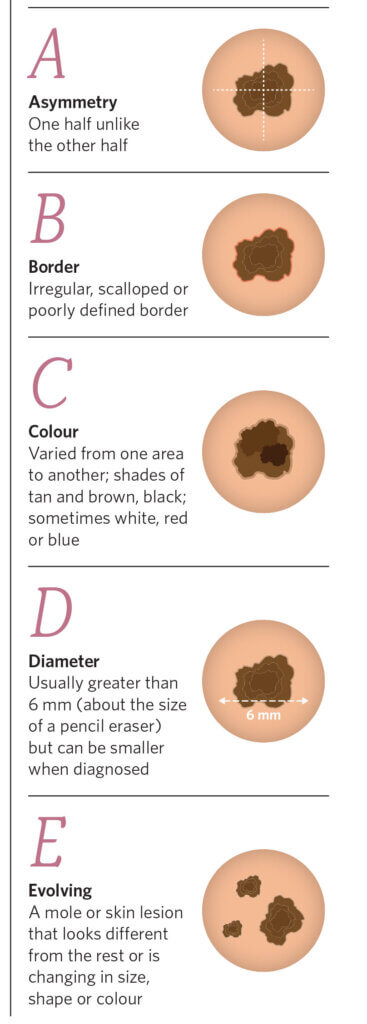Did you know that the majority of skin changes we associate with ‘aging’ are actually caused by sun damage? With exposure to the sun’s ultraviolet light over time, the elastin fibres in the skin are significantly damaged. As elastin breaks down, the skin will begin to sag and lose the ability to regain its shape.
Your skin’s outer layer is made up of cells that contain a pigment called melanin that helps to protect your skin from the sun’s rays. However, melanin can only do so much—sunscreen acts as a shield for your skin cells and protects your skin from damage.
Sun damage can show up in the form of:
• Reduced skin elasticity and thicker texture;
• Freckles, discoloured pigmentation, sunspots;
• Telangiectasias – the dilation of small blood vessels under the skin;
• Premature aging of the skin that causes wrinkles; and
• Skin cancer.
Sun damage isn’t just about the visible marks, spots, and signs of aging—the rays are carcinogenic. UVA and UVB rays suppress certain activities of the immune system, playing a key role in the development of skin cancer.
Yes, both UVA and UVB are team cancer, and they’re working both angles to make it happen. While UVB burns your skin, showing you damage right away, UVA works to penetrate deep into your skin with no immediate warning signs.
Of the UV solar radiation that does reach us here on earth, up to 95% is UVA, and about 5% is UVB. You need a broad-spectrum sunscreen, every day, all year-round, to protect against both.
There are three main types of skin cancer: basal cell carcinoma, squamous cell carcinoma and melanoma. Basal cell and squamous cell cancers are often less serious types and make up 95% of all skin cancers. These two types are highly curable when detected and treated early, as they develop within the epidermis. Melanoma, made up of abnormal skin pigment cells called melanocytes, is the most serious form of skin cancer and causes 75% of all skin cancer deaths. Left untreated, it can spread to other organs and is difficult to control.
What Are the Symptoms of Skin Cancer?
• The most common warning sign of skin cancer is a change on the skin, typically a new mole or skin lesion or a change in an existing mole.
• Basal cell carcinoma may appear as a small, smooth, pearly or waxy bump on the face, ears or neck, or as a flat pink, red or brown lesion on the trunk or arms and legs.
• Squamous cell carcinoma can appear as a firm, red nodule, or as a rough, scaly flat lesion that may bleed and become crusty. Both basal cell and squamous cell cancers mainly occur on areas of the skin frequently exposed to the sun, but can occur anywhere.
• Melanoma usually appears as a pigmented patch or bump but can also be red or white. It may resemble a normal mole, but usually has a more irregular appearance.
The ABCDEs of Melanoma
Melanoma is the deadliest form of skin cancer. However, when detected early, melanoma is highly treatable. You can identify the warning signs of melanoma by looking for the following:

How Can I Help Prevent Skin Cancer?
It is never too late to begin protecting yourself from the sun! Nothing can completely reverse sun damage, although the skin can partially repair itself, especially with continued sun protection. Your skin does change as you age, but you can delay some of these changes by protecting your skin from the sun.
AHAs and vitamin A both have a potential to increase your skin’s sun sensitivity so utilize these as part of your evening routine (slowly introduce to your skin) and be sure to follow with sunscreen in the morning.
I have a personal mission to increase skin cancer awareness and early detection, as it something that I continue to experience. I hate to think that the ill-made choices in my late teens and early twenties of using tanning beds and not using sunscreen, have caused me to continue to have skin cancer occurrences. That tan is just not worth it!
I noticed a mole slightly darken on the side of a hip; it wasn’t big and did not look different from my other moles, but it had changed slightly in colour. My family doctor assured me that my mole was nothing to worry about, but I was confident that it had changed. I insisted on a biopsy which resulted in my melanoma diagnosis and two excision surgeries. I have since had several other cancerous removals, most of which are basal cell carcinomas. Being told that you have cancer is incredibly frightening and while skin cancer can be highly treatable when detected early, that does not minimize the impact of hearing those words. Skin cancer is cancer.
Brianne Rempel is just as passionate about clean beauty and skin care as she is about self-growth and kindness. As our health and beauty specialist, Brianne helps us select plant-based personal care products that are eco-friendly yet effective, and she trains our team members so you can make the most of your skincare regime. Brianne brings 20 years of retail experience, where she enjoyed the chance to positively impact store culture and perfect the workplace hug.
